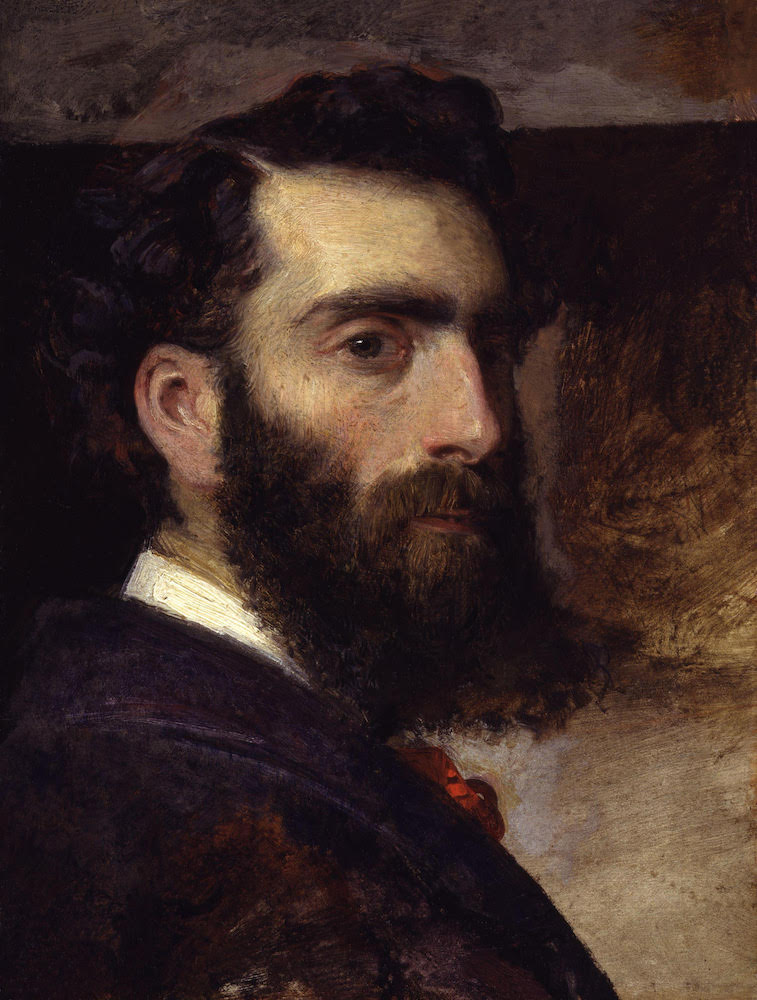
Philip H. Calderon by unknown artist, possibly a self-portrait, © National Portrait Gallery, London, accession no. NPG 6498, by kind permission.
.Calderon was born on 3 May 1833 in Poitiers, France, the only son of a Spanish father and a French mother, Marguerite Chappelle. His father, the Rev. Juan Calderon, had once been a Catholic priest but left the church in order to marry and had therefore converted to Anglicanism. The family moved to London in 1845 when Philip was aged twelve. His father became Professor of Spanish Literature at King's College, London. Philip received his early education primarily from his father.
Although Philip initially had planned to become an engineer, and in fact was the pupil of a civil engineer, he became interested in drawing and amused himself by copying from prints after Raphael. Becoming aware that engineering was not to be Calderon's calling in life, his master persuaded Philip's father to allow him to become an artist. In 1850 Philip entered J. M. Leigh's art school at 79 Newman Street. In 1851 he left for Paris to study under François-Édouard Picot. While in Paris he shared a room with his fellow art student Henry Stacy Marks whom he had earlier met at Leigh's.
When Calderon returned to London he studied at the British Museum and copied from the Old Masters in the National Gallery during the day and attended Leigh's Academy in the evenings. Calderon first exhibited at the Royal Academy in 1853 and finally had a major success in 1857 with Broken Vows, painted under the influence of the Pre-Raphaelites. He also exhibited at the British Institution, the Society of British Artists, the Dudley Gallery, and later at the Grosvenor Gallery. In 1861 he was awarded the silver medal by the Society of Arts for his painting La Demande en Mariage. He was the leader of the St. John's Wood Clique, which also included G. D. Leslie, H. S. Marks, G. A. Storey, W. F. Yeames and D. W. Wynfield. In May 1860 he married Clara Marianne Storey, the sister of his friend G. A. Storey.
Calderon was elected A.R.A. in 1864 and R.A. in 1867. He had a studio built for himself in Marlbrough Place designed by the architect George Aitchison. In 1867 Calderon won a gold medal at the Exposition Universelle in Paris for his painting Her Most High, Noble and Puissant Grace. He was also honoured with a medal in Vienna in 1873. In 1878 he won another first-class medal in Paris at the Exposition Universelle and was made a Knight of the Legion of Honour.
In 1887 Calderon was appointed Keeper of the Royal Academy. He was tasked with the running of the Royal Acadmy Schools, which together with his other administrative responsibilites, left him less time for painting his own pictures. He moved from his house Weston Lodge at 16 Grove End Road in St. John's Wood to occupy rooms in Burlington House set apart for the keeper of the Royal Academy. Calderon died on April 30, 1898 at Burlington House after a protracted illness and was buried in Kensal Green cemetery.
Campbell Dodgson, when commenting on Calderon as an artist, stated: "Calderon's admirable draughtsmanship and sound technique secured the esteem of artists for his work. He probably owed much of his popularity with the general public to his choice of subjects. Most of his pictures tell a story, usually one of his own invention, sometimes a subject from history or literature." Noting that Calderon "resembled Millais in his power of representing a dramatic or pathetic incident," he pointed out that his work too usually featured "few actors on the scene, with a simplicity which appealed at once to the intelligence and the sympathy of the crowd which frequents the Royal Academy exhibitions," adding that part of his appeal was the use of "bright and agreeable colouring."
Bibliography
Dodgson, Campbell. "Philip Hermogenes Calderon." Dictionary of National Biography, Vol. I, 1901 supplement.
Fenn, W. W. "Our Living Artists: Philip Hermogenes Calderon R.A. The Magazine of Art (1878): 197-202.
Stephens, Frederic George. "Mr. Philip Hermogenes Calderon, R.A., Keeper." The Athenaeum No. 3680 (May 7, 1898): 605.
Storey, George Adolphus. "Philip Hermogenes Calderon, A. R. A. (1833-98)." The Magazine of Art XXII (1898): 446-52. [Complete text in the Victorian Web.]
Created 11 July 2023